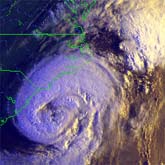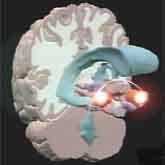Hurricanes, The Basics
 There is nothing like them in the atmosphere. Born in warm tropical waters, these spiraling masses require a complex combination of atmospheric processes to grow, mature, and then die. They are not the largest storm systems in our atmosphere or the most violent, but they combine these qualities as no other phenomenon does. In the Atlantic Basin, they are called hurricanes, a term that echoes colonial Spanish and Caribbean Indian words for evil spirits and big winds. These awesome storms have been a deadly problem for residents and sailors ever since the early days of colonization. The ingredients for a hurricane include a pre-existing weather disturbance, warm tropical oceans, moisture, and relatively light winds aloft. If the right conditions persist long enough, they can combine to produce the violent winds, incredible waves, torrential rains, and floods we associate with this phenomenon.
There is nothing like them in the atmosphere. Born in warm tropical waters, these spiraling masses require a complex combination of atmospheric processes to grow, mature, and then die. They are not the largest storm systems in our atmosphere or the most violent, but they combine these qualities as no other phenomenon does. In the Atlantic Basin, they are called hurricanes, a term that echoes colonial Spanish and Caribbean Indian words for evil spirits and big winds. These awesome storms have been a deadly problem for residents and sailors ever since the early days of colonization. The ingredients for a hurricane include a pre-existing weather disturbance, warm tropical oceans, moisture, and relatively light winds aloft. If the right conditions persist long enough, they can combine to produce the violent winds, incredible waves, torrential rains, and floods we associate with this phenomenon.
A hurricane is a type of tropical cyclone, which is a generic term for a low pressure system that generally forms in the tropics. The cyclone is accompanied by thunderstorms and, in the Northern Hemisphere, a counterclockwise circulation of winds near the earth's surface. Hurricanes are categorized according to the strength of their winds using the Saffir-Simpson Hurricane Scale. A Category 1 storm has the lowest wind speeds, while a Category 5 hurricane has the strongest. These are relative terms, because lower category storms can sometimes inflict greater damage than higher category storms, depending on where they strike and the particular hazards they bring. In fact, tropical storms can also produce significant damage and loss of life, mainly due to flooding.
When the winds from these storms reach 39 mph (34 kt), the cyclone is given a name. Years ago, an international committee developed six separate lists of names for these storms. Each list alternates between male and female names. The use of these easily remembered names greatly reduces confusion when two or more tropical cyclones occur at the same time. Each list is reused every six years, although hurricane names that have resulted in substantial damage or death are retired.The National Weather Service (NWS) has several tools to monitor hurricanes. While they are still far out in the ocean, indirect measurements using satellites are the main tool, although ships and buoys also provide observations. Once the storms come closer to land, more direct measurements (reconnaissance aircraft, radiosondes, and Automated Surface Observing Stations) are also used. Within about 200 miles of the coast, radar provide important indirect measurements of the storm.







